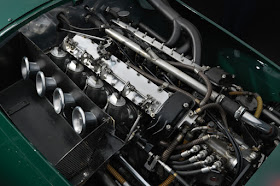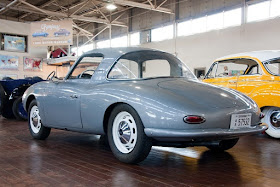This is the second in a survey of British attempts to make a comeback in Formula One racing. Nowadays, it's hard to imagine a time when British cars and drivers were absent from the winner's circle. But in the middle of the 1950s, the last win for a British car in a Grand Prix was three decades back in the rear view mirror. The efforts of BRM with their expensive and complex V-16 had failed because the car was unreliable as well as very tricky to drive, but the under-funded Connaught* team's surprise victory at the non-Championship Syracuse GP may have given hope to other teams, including the makers of this Vanwall. Tony Vandervell was the London manufacturer of a successful line of precision automotive bearings, trademarked "Thinwall". Like Briggs Cunningham* in the USA, his team gained some experience running foreign machinery in their early efforts. In both cases this involved Ferraris; Cunningham imported the first one to appear in America, and Vandervell campaigned four Ferrari GP cars as Thinwall Specials from 1949 to '53 before making his first car the next year. Having observed at close quarters the failure of the overly-ambitious "clean sheet of paper" approach (along with "not invented here" resistance to ideas) as a supporter of that first BRM effort, Vandervell took a more pragmatic approach. He'd raced Norton motorcycles in the 1920s and now sat on the company's board, and this led to the approach of combining four 500cc single cylinder assemblies from the Norton racing engine into a new water-cooled block with twin overhead cams. Norton engineers employed a crankcase derived from the Rolls Royce B40 military engine; and while displacement was originally 500cc under the under the new-for-1954 F1 limit, it was gradually increased to 2,490cc. The early engines had 4 Amal carburetors, but power went up after Vandervell coaxed Mercedes to release copies of the Bosch mechanical fuel injection used on their cars; he'd supplied bearings to Daimler-Benz.
The first engine worked well enough that Peter Collins finished 2nd to Stirling Moss (Maserati 250F) in the '54 Goodwood Trophy. For brakes Vandervell went to Goodyear in the US, and got aircraft-derived discs which seemed more effective than those from Dunlop. In this way at least, the Vanwall outfit's approach looked a lot like the globalist car industry that would appear in another thirty years... The tubular chassis was by Cooper Cars, but Cooper may have been saving their most inspired work for their upcoming mid-engined F1 cars, and at the end of 1955 the Vanwall team approached a new chassis engineer named Colin Chapman, who in turn suggested he'd like to work with a promising young aerodynamicist named Frank Costin. What they did was shift the driver over the Ferrari-derived transaxle and surround him with a structure of thin tubes. They bet everything on the idea that the resulting increase in frontal area (it was then the tallest GP car) would be offset by much smoother airflow around the cockpit and tail.
They were right; even though the Vanwall had less horsepower (262) than the 270 to 275 of the Maserati and Ferrari, those cars couldn't catch it on long straights. In terms of top speed, the Vanwall was the fastest of the period, and its ovoid, windswept forms made it perhaps the most distinctive of the front-engined racers, a format that would disappear with the new Formula 1 in 1961. But in 1958, Tony Brooks and Stirling Moss each won enough races (3) to insure that Vanwall won the Manufacturer's Championship, a victory sadly marred by teammate Stuart Lewis-Evans' fatal accident in the final race. Moss also raced a Cooper for Rob Walker's privateer team that year, and lost out in the Driver's Championship by one point to Mike Hawthorn in a Ferrari. The Vanwall, however much it may have been as assemblage of mostly off-the-shelf what-have-you concealed beneath a slippery shell, had done its job...
*Footnote: For more on the Connaught and Tony Brooks, who later became famous in the Vanwall, see "Celtic Rainmaker: Connaught Broke the Longest Drought in Grand Prix Racing" in our post for 7/24/16. We covered Cunningham's efforts at Le Mans in "A Moment Too Soon: The Cars of Briggs Swift Cunningham" on 4/15/17.
Photo Credits:
Top: the author
2nd: revsinstitute.org
2nd: revsinstitute.org
3rd: Paul Anderson
Bottom photo shows Stirling Moss at tea time, testing a Vanwall:
credited to Enrico Brunoni on pinterest.com
Bottom photo shows Stirling Moss at tea time, testing a Vanwall:
credited to Enrico Brunoni on pinterest.com




















































